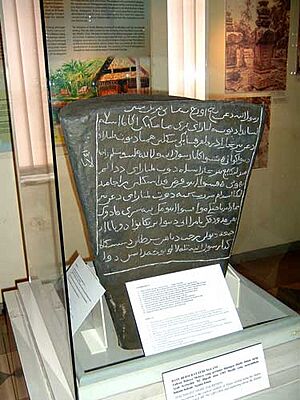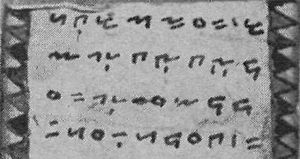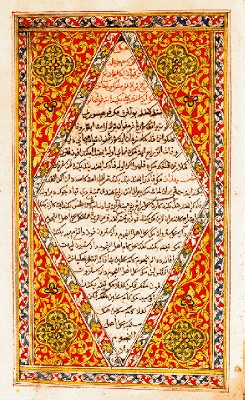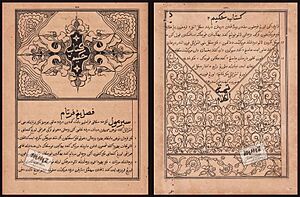History of the Malay language facts for kids
The Malay language is an old language from the Austronesian language family. It has changed a lot over thousands of years. This happened because of trade, new religions, and different rulers. The very first form of Malay came from the Proto-Malayo-Polynesian language. This was spoken by the first people who settled in Southeast Asia. Later, when Indian cultures arrived, it became what we call Old Malay.
Old Malay then grew into Classical Malay. This happened as many Arabic and Persian words were added, especially when Islam spread in the region. At first, Classical Malay had many different forms. But one form, used in the Malacca Sultanate in the 1400s, became the most important. Because Malacca was a big trading hub, Malay became a lingua franca. This means it was a common language used for trade and talking between different groups. Malay kept this important role through different eras, even today. From the 1800s to the 1900s, Malay improved a lot. It gained new grammar rules and many more words, becoming the modern language we know.
Contents
Early Malay: Proto-Malayic
Proto-Malayic is thought to be a very old language. It was spoken by the first Austronesian people who settled in Southeast Asia. This language came from an even older one, the Proto-Malayo-Polynesian language. This older language started to split up around 2000 BCE. This happened as people moved south from Taiwan to places like the Philippines, Borneo, and Maluku.
Proto-Malayic was spoken in Borneo by at least 1000 BCE. Many experts believe it is the ancestor of all later Malay dialects. Linguists think Borneo is where the Malayic family began. This is because of how widely it spread there. Also, its different forms were not just from contact with other languages. Around 1 CE, Malayic speakers set up homes in coastal areas. These included modern-day Sumatra, the Malay Peninsula, and other islands.
Old Malay (7th to 14th century)
Around the start of the common era, Indian culture became very important in the region. With Indian influence, including words from Old Tamil and religions like Hinduism and Buddhism, Ancient Malay changed into Old Malay.
The oldest clear examples of Old Malay writing are from the 600s CE. These include the Sojomerto inscription from Central Java and the Kedukan Bukit Inscription from South Sumatra. Other writings from the 600s to 900s were found in Sumatra, Java, and other islands. All these Old Malay writings used scripts from India. These were scripts like Pallava or Nagari.
The Old Malay language was greatly shaped by Sanskrit. Sanskrit influenced its sounds, word parts, and vocabulary. Many words related to Indian culture came into Malay. Examples include puja (worship) and raja (king). Words about Hindu-Buddhist religion also came in. These include neraka (hell) and syurga (heaven). Some of these words are still used today. Even some Malay names come from Sanskrit, like Puteri and Wira.
Some linguists believe the Old Malay from the Srivijayan writings in Sumatra is the ancestor of Classical Malay. However, this link is not fully clear. This is because the Srivijayan language has some unique features. These features are found in the Batak language but not in early Classical Malay. So, it might be a close relative rather than a direct ancestor. Old Malay was still written in Sumatra until the late 1300s.
Classical Malay (14th to 18th century)

Classical Malay began when Islam became a major religion in the region. With the spread of Islam and more trade with Muslim countries, many Arabic and Persian words entered Malay. Islamic culture also blended with local Malay culture.
The earliest Arabic words in Malay were found in the Minye Tujoh inscription from 1380 CE in Aceh. But an even earlier example is the 1303 CE Terengganu Inscription Stone. This stone, found in the Malay Peninsula, shows Islam as a state religion. It also has the oldest example of the main Classical Malay writing style, the Jawi script. Similar writings with Arabic words were found in Sumatra and Borneo.
Classical Malay became very refined during the golden age of the Malacca Sultanate and its successor, the Johor Sultanate, starting in the 1400s. Malacca was a busy port city with many people from different nations. It became a mix of cultures and languages. More words from Arabic, Persian, Tamil, and Chinese were added. This period saw a flourishing of Classical Malay literature. There were also improvements in royal leadership and public administration.
Unlike Old Malay, Malacca's writings covered more than just stories and religious works. They included topics like accountancy, maritime laws, and trade licences. Important books from this time include Undang-Undang Melaka (Laws of Malacca). Many foreign literary works were also translated. New intellectual writings in philosophy, history, and other fields also appeared. Famous examples are the Malay Annals and Hikayat Hang Tuah.
Malacca's success made Classical Malay very important. It became the main lingua franca for the whole region. Through trade and contact, Classical Malay spread beyond the traditional Malay-speaking areas. This led to a trade language called Melayu Pasar ("Bazaar Malay"). This was different from the formal Melayu Tinggi (High Malay) of Malacca-Johor. Bazaar Malay was a simpler language, perhaps influenced by traders from different backgrounds. This simpler Malay later developed into new languages. Examples include Baba Malay and Betawi Malay.
Besides trade and spreading Islam, Malay also became a court and literary language. It was used in kingdoms outside its main area, like Aceh. It was also used in letters with European colonial powers. For example, letters from the Sultan of Aceh to King James I of England in 1615 were written in Malay.
During this time, foreigners became very interested in learning Malay. They needed it for trade, diplomatic visits, and missionary work. So, many word lists and dictionaries were created. The oldest was a Chinese-Malay word list from the Ming Dynasty. It was called Man-la-jia Yiyu (Translated Words of Malacca). It had 482 words in 17 different categories.
In 1522, the first European-Malay word list was made by Antonio Pigafetta. He was an Italian explorer with Magellan's journey around the world. His Italian-Malay list had about 426 words. It became a key reference for later Latin-Malay and French-Malay dictionaries.
European colonization began in the 1500s with the Portuguese. Then came the Dutch in the 1600s and the British in the 1700s. This period also saw the start of Christianisation in the region. Places like Malacca and Ambon became strongholds. Bible translations began as early as the 1600s. A Dutch trader, Albert Ruyll, started translating religious books into Malay in 1611. His book, Sovrat A B C, taught the Latin alphabet and basic Christian beliefs. Many parts of the Bible were later translated into Malay.
Pre-Modern Malay (19th century)
The 1800s saw strong Western control in the Malay region. The 1824 Anglo-Dutch Treaty divided the area. The Dutch controlled the Dutch East Indies (Indonesia). The British held colonies in the Malay Peninsula and British Borneo. Both the Dutch and British understood the importance of Malay. They set up centers to study Malay language and culture in universities. Thousands of Malay writings and artifacts were collected.
The use of the Latin script began to grow in government and education. English and Dutch literature and languages slowly influenced Malay.
At the same time, new printing methods made it cheaper to produce many books. This led to more writing for general readers, moving Malay literature beyond just royal courts. Journalism also began to grow in Malay writing.
A famous writer from this time was Abdullah Munsyi from Malacca. His well-known works include Hikayat Abdullah (1840). Abdullah's work helped Malay literature move from folk tales to more accurate historical descriptions. He also helped publish the first known Malay magazine in 1831. Abdullah Munsyi is called the "Father of Modern Malay Literature." He was the first local Malay writer to have his works published.
Many other important books were published. These include Gurindam Dua Belas (1847) by Raja Ali Haji. Female writers also became active. Raja Aisyah Sulaiman, Raja Ali Haji's granddaughter, wrote Hikayat Syamsul Anwar (1890). In this book, she shared her feelings about her marriage and traditions.
Scholars in Riau-Lingga formed the Rusydiyah Club. This was one of the first Malay literary groups. They discussed writing and publishing in the late 1800s. Many religious books from this era were also published in other countries like Egypt and Turkey.
Some of the earliest Malay newspapers appeared. Soerat Kabar Bahasa Malaijoe was published in Surabaya in 1856. Jawi Peranakan was published in Singapore in 1876. There was even a Malay newspaper in Sri Lanka in 1869, Alamat Langkapuri. It was the first Malay newspaper published in Jawi script.
In education, the Malay language of Malacca-Johor became the standard. It was used to teach in schools during the colonial period. Starting in 1821, British schools in Penang, Malacca, and Singapore used Malay. This led to the creation of Malay textbooks, dictionaries, and grammar books. Malay also became important in British administration. Public servants had to pass a Malay language exam to get a permanent job.
In Indonesia, the Dutch government recognized the Malacca-Johor Malay from Riau-Lingga as "High Malay." They promoted it for communication between the Dutch and local people. It was taught in schools in Riau and other parts of Indonesia.
Modern Malay (20th century to present)
The growth of pre-modern Malay literature in the 1800s led to new ideas among local people. New Malay language experts emerged. People valued the language more. They worked to improve Malay and help it face modern challenges.
One effort was to plan a text corpus for Malay. This was started in 1888 by a society for learning language. This society later became the Johor Royal Society of Malay Language and Literary Works. They actively worked on spelling rules, dictionaries, and grammar. The Sultan Idris Training College (SITC) in Tanjung Malim intensified these efforts in 1922. In 1936, Za'ba, a great Malay scholar at SITC, wrote a Malay grammar book series called Pelita Bahasa. This book modernized Classical Malay and became the basis for today's Malay language. A key change was moving from passive to active sentence structures. Other groups and governments also made improvements in the 1900s.
Writing played a special role in the fight for independence in Indonesia and Malaysia. Newspapers and journals like Al-Imam (1906) and Warta Malaya (1931) helped spread knowledge. They also became key tools in promoting nationalism. Novels, short stories, and poems all helped to inspire the spirit of Indonesian National Awakening and Malay nationalism.
During the first Kongres Pemuda (Youth Congress) in Indonesia in 1926, Malay was declared the unifying language for Indonesia. In 1945, this language, called "bahasa Indonesia" (Indonesian), became the national language in Indonesia's constitution. Later, in 1957, Malay became the national language for the independent Federation of Malaya (now Malaysia). In 1959, Malay also became the national language in Brunei. When Singapore left Malaysia in 1965, Malay became its national language and one of its four official languages. These new independent countries led to wider use of Malay (or Indonesian) in government and education. Colleges and universities began using Malay as their main teaching language.
Indonesian, as Indonesia's unifying language, is open to influences from other local languages. It also takes words from Dutch (the former colonizer) and English. So, Indonesian has more sources for borrowed words compared to Malay in Malaysia, Singapore, and Brunei. Some say Indonesian is an "artificial language" because academics designed it. This was to create an official unifying language for Indonesia. But it also naturally borrowed from many languages.
This different development of Indonesian led to a need for cooperation. In 1959, Malaya and Indonesia started working together on language. This was strengthened in 1972 with the formation of MBIM (Language Council of Indonesia-Malaysia). MBIM later became MABBIM in 1985, including Brunei. Singapore is a permanent observer. Another important body is Dewan Bahasa dan Pustaka, set up in 1956. It coordinates the use of Malay in Malaysia and Brunei.
The main writing system for Modern Malay is the Latin script, known as the Malay alphabet. It was developed in the early 1900s. Since Malay-speaking countries were under Dutch and British rule, two different spelling systems emerged. These were influenced by Dutch and English spelling. In 1901, the Van Ophuijsen Spelling System became standard in the Dutch East Indies. In 1904, the "Wilkinson Spelling System" was developed in British Malaya. These systems were later replaced.
During the Japanese occupation, a system called Fajar Asia tried to unify the spelling. But it only existed during that time. In 1972, Malaysia and Indonesia agreed on a joint spelling system. It is called Ejaan Rumi Baharu (New Rumi Spelling) in Malaysia and Sistem Ejaan Yang Disempurnakan (Perfected Spelling System) in Indonesia. This common system helps with clear communication in government and education.
Even with the widespread use of the Malay alphabet, the Jawi script is still important. It is one of two official scripts in Brunei. It is also used as an alternate script in Malaysia. Jawi is still used daily in more traditional Malay areas. These include Pattani in Thailand and Kelantan in Malaysia. It is used for religious and cultural administration in several Malaysian states. Its influence is still seen in the Philippines. In Indonesia, Jawi is widely used in Riau province for road signs and government buildings.
See also
 In Spanish: Historia del idioma malayo para niños
In Spanish: Historia del idioma malayo para niños
- Malay literature
- Malaysian literature
- Indonesian literature
- Malay folklore
- Ethnic Malays
- Malayisation
- List of Hikayat






